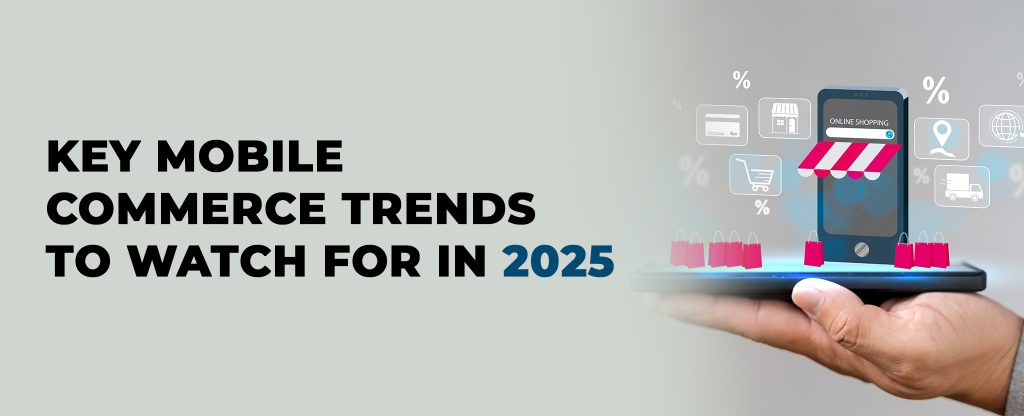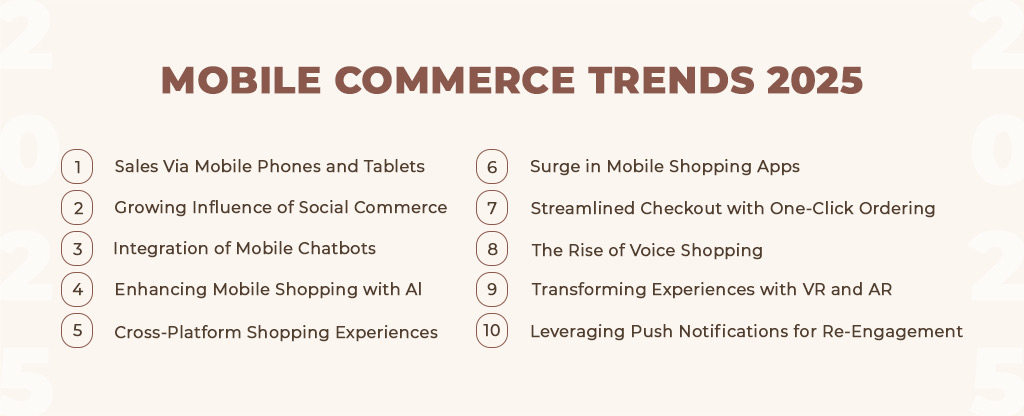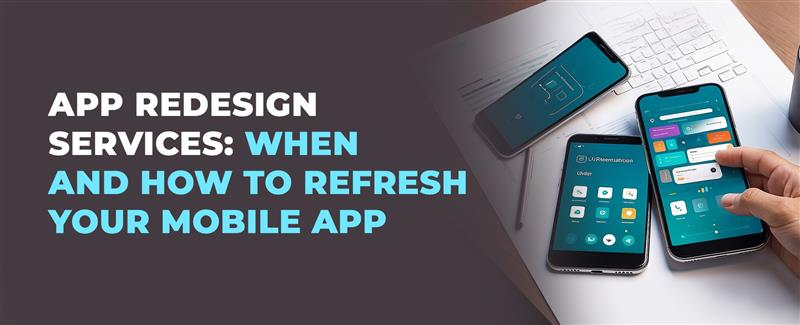Key Mobile Commerce Trends to Watch for in 2025
18 Jan 25 


Mobile technology has become the foundation of modern living. It’s now such an essential part of our daily lives that imagining a world without smartphones seems impossible. From how we talk to others to how we buy things, these devices have changed our everyday activities. This shift has led to the quick rise of mobile commerce (m-commerce), changing both how people shop online and how companies connect with their customers.
M-commerce helps companies keep their service quality the same across different ways of buying. It lets businesses better serve their customers’ needs, building trust and keeping customers coming back. With this growing influence, the global omnichannel retail commerce market is expected to grow from $6.57 billion in 2023 to $11.24 billion by 2028.
A major force behind global e-commerce growth is the rise in mobile shopping. According to Statista’s Digital Market Insights, mobile e-commerce sales brought in about $1.7 trillion in revenue in 2023, making up more than half of all online retail sales. This mobile trend keeps growing, with its share expected to rise from 43% in 2018 to 63% by 2028.
E-commerce businesses need to keep up with new mobile commerce trends and how they affect buyer behavior. Mobile device users are leading today’s digital economy, shaping how online buying will work in the future. Not paying attention to these changes can mean missing out in an increasingly competitive market.
To help businesses stay ahead, we’ve found the top mobile commerce trends that will be important in 2025. These insights come from thorough research and watching industry changes. Let’s look at these trends to help your business stay current and successful in the changing world of mobile commerce.
Why is Mobile Commerce Experiencing Exponential Growth?
By 2025, over 70% of all online purchases will happen through mobile devices. This isn’t just a number; it shows how mobile devices have become part of our everyday lives. Whether people are looking at products during breakfast or buying things while on the bus, mobile commerce trends have made shopping possible anywhere, anytime. But what’s causing this quick growth?
Key factors driving mobile commerce trends
Unmatched Accessibility and Convenience
Affordable smartphones and fast internet have made mobile commerce available to billions of people worldwide. People can now shop easily without needing a computer or going to a store. Being able to buy things instantly from anywhere has made mobile commerce many people’s favorite way to shop. This ease of use has greatly increased its popularity worldwide.
Immersive and Engaging User Experiences
Modern shopping apps focus on clean, attractive designs, easy-to-use navigation, and recommendations that match each user’s interests. These elements make shopping feel more like fun and less like work. When users get instant messages about sales or time-limited deals, it creates excitement and keeps them interested. These new ways of mobile shopping are changing how loyal customers feel and how happy they are with their experience.

Advanced Technologies Revolutionizing Shopping
New technology like Artificial intelligence, augmented reality (AR), and shopping by voice are making mobile shopping better than ever. AI systems suggest products based on what each customer likes, helping them find exactly what they want. AR technology lets shoppers see how things would look in real life – like placing furniture in their room or trying on makeup virtually – before buying. At the same time, voice commands make it easy to shop while doing other things or moving around. These improvements make mobile shopping not just easier but more interactive and fun.
Mobile Commerce Trends 2025
The growing world of mobile commerce (m-commerce) is changing online shopping by using new technologies and features that focus on what users want. Here’s what’s shaping the future of m-commerce:

Surge in Mobile Shopping Apps
More and more shoppers prefer using apps instead of websites for buying things, as apps work better and are more convenient.
- Changing Shopping Habits: People aren’t using regular web browsers as much to find products anymore. Instead, 57% of US shoppers use retail apps to learn about products, showing a big change in how people shop.
- Mobile-Friendly Isn’t Enough: While having a website that works well on phones is important, it’s just the starting point now. Apps offer better features like personal suggestions, faster browsing, and easier use.
- High Conversion Rates: Mobile apps lead to 157% more sales than mobile websites, making them very important for Shopify store owners. This happens because apps save user information, give special offers, and are easier to use.
- The Need to Act Now: Starting early with an app gives businesses an advantage. Waiting too long could mean losing customers to competitors.
Sales Via Mobile Phones and Tablets
Smartphones are leading in mobile shopping sales. In 2024, smartphone sales reached over $418 billion, much more than the $69 billion from tablets. This difference is expected to grow as tablet sales keep dropping each year.
Businesses need to understand that smartphones are most important and plan accordingly. For example, shopping apps made for smartphones can send timely offers based on how and where people use their phones. These messages work better on smartphones because people usually see and respond to them right away, unlike on tablets that people might check less often.
Although tablets are important, businesses selling online should mainly focus on making their services work well for smartphone users in 2025. This helps them stay in line with how people shop and use technology today.
Streamlined Checkout with One-Click Ordering
Shopping apps are making it much easier to buy things online. Before, when people wanted to buy something on the internet, they had to type in all their details like name, address, and payment information each time. This was slow and frustrating, especially on small phone screens.
This difficult process is why so many people (97%) leave items in their shopping carts on mobile websites without buying them. But with shopping apps, only 20% of people do this. The big difference is that apps can save your information, making future purchases much easier.
One-click ordering lets shoppers buy things instantly without entering their information again and again. This makes shopping more enjoyable and helps businesses sell more. Studies show that people who use apps spend twice as much as those who shop on computers or mobile websites. When businesses use one-click ordering, they can sell more quickly and keep their customers happier.
Growing Influence of Social Commerce
Social media platforms now include shopping features, making it simple for people to buy products directly from social media posts. This has made it much easier to go from seeing something you like on social media to buying it.
Features on Instagram and Facebook’s shopping pages let businesses add price tags to their posts. Shoppers can click these tags to buy items right away without visiting many different pages. This gives online stores a great chance to reach customers who use social media every day.
Social commerce really works – the numbers prove it. Businesses using Instagram’s shopping features have seen their website visits go up by over 1,400% and their sales increase by 20%. As more people use these features, they’re expected to become even more important for mobile shopping in 2025.
The Rise of Voice Shopping
Voice search has become an important tool for online shopping. While people first used voice assistants like Siri and Alexa for basic tasks like weather updates or playing music, they’re now using them to shop online.
In 2023, voice shopping grew to $40 billion in market value, up significantly from $2 billion in 2018. Today, 40% of adults use voice search every day, and 20% of all mobile searches are done by voice, showing huge room for growth in this area.
People now use voice commands to research products and make purchases. Online businesses need to make their websites and apps work well with voice search. This helps both phone users and smart speaker owners easily connect with the brand, keeping the business current in this fast-changing market.
Integration of Mobile Chatbots
While chatbots aren’t new, shopping apps have been slow to use them. However, this is expected to change a lot by 2025. Chatbots help businesses respond faster, serve customers better, and spend less money on operations.
Chatbot mobile apps help users right away by answering questions, suggesting products, and helping with purchases. Research shows that over half of users like using chatbots if it saves them time. When businesses add chatbots to their apps, they make shopping better while spending less on customer support.
Transforming Experiences with VR and AR
Virtual reality and augmented reality are changing mobile shopping. Stores are using AR to show customers how products would look in real life. For example, furniture stores can show how a piece would look in someone’s house.
This helps remove uncertainty from online shopping by making it more interactive. The AR and VR market is expected to grow to $35 billion by 2025, with some of this money coming from retail uses.
In fashion, AR helps customers find clothes that fit by measuring them virtually. This personalized experience makes customers happier and reduces returns, making AR and VR important tools for future online shopping growth.
Enhancing Mobile Shopping with AI
Artificial Intelligence (AI) is becoming very important in mobile shopping, changing how businesses understand and help their customers. AI tools like recommendation systems study customer behavior, what they’ve bought before, and what they like to suggest products they might want.
For instance, when people use a shopping app on their phone, AI systems can show them items they’re more likely to buy based on what they’ve looked at before. This makes them more likely to buy while making shopping more interesting.
AI also runs chatbots and digital helpers that assist customers right away. These tools can handle questions, show products, and help with returns, making customers much happier. When businesses use AI, they can work better, spend less money, and create a smooth shopping experience that fits each person.
Utilising Push Notifications for Re-Engagement
Push notifications are a useful feature in shopping apps that let businesses talk directly with their customers. These messages allow companies to send personal updates, like special deals, new product announcements, or reminders about items left in shopping carts.
Unlike emails, push notifications show up right on someone’s phone screen, making them more likely to be seen and acted on. Research shows that push notifications can make app use go up by 88%, making them very important for getting inactive users back.
For example, if someone adds things to their cart but doesn’t buy them, a well-timed push notification with a special deal can encourage them to complete their purchase. Also, messages about time-limited sales or personal product suggestions keep people coming back to the app. When businesses use this feature well, they can keep more customers and sell more products.
Cross-Platform Shopping Experiences
Today’s shoppers want a smooth experience across all their devices. They might start looking at products on their computer, keep researching on their phone, and finally buy on their tablet. Making sure everything works the same across these devices is key for online store success in 2025.
Working across platforms is especially important for phone apps, which should work smoothly with computer and tablet versions. Features like saved shopping carts, wish lists that update everywhere, and one login for all devices make switching between them easy and improve shopping.
For instance, when someone logs into their account on a computer, they should see the same saved items when they switch to the phone app. This consistency makes things convenient and builds customer trust. Businesses that focus on cross-platform shopping are better prepared to meet what today’s tech-smart shoppers want and build long-term loyalty.
Conclusion
Mobile trends will keep shaping how online shopping grows. If you run an online store, you need to stay current with mobile shopping advances to match how people shop today.
Looking at mobile shopping trends, one thing stands out: the importance of mobile apps. Mobile app development companies provide convenience and personal shopping experiences that are needed to attract and keep customers. By getting a mobile app for your online store, you can serve how people prefer to shop in 2025.
Developing a mobile app is no longer optional – it’s essential to stay competitive in today’s fast-changing tech world. Apps help businesses create smooth user experiences, provide custom suggestions, and make buying easier. These features match what shoppers want most today – quick service and personal attention.
The trends and practices we’ve discussed offer clear steps to help your business succeed in mobile commerce. Use these strategies to make your store stand out in the competitive online shopping world of 2025. Being ready to adapt and take action will help your business grow stronger in the changing landscape of mobile technology.
- Agentic AI1
- Android Development3
- Artificial Intelligence34
- Classified App3
- Custom App Development5
- Digital Transformation12
- Doctor Appointment Booking App14
- Dropshipping1
- Ecommerce Apps40
- Education Apps2
- Fintech-Apps37
- Fitness App4
- Flutter4
- Flutter Apps20
- Food Delivery App5
- Grocery App Development1
- Grocery Apps3
- Health Care10
- IoT2
- Loyalty Programs9
- Matrimony Apps1
- Microsoft1
- Mobile App Maintenance2
- Mobile Apps129
- Product Engineering6
- Progressive Web Apps1
- React Native Apps2
- Saas Application2
- Shopify9
- Software Development3
- Taxi Booking Apps7
- Truck Booking App5
- UI UX Design8
- Uncategorized6
- Web App Development1



















Comments